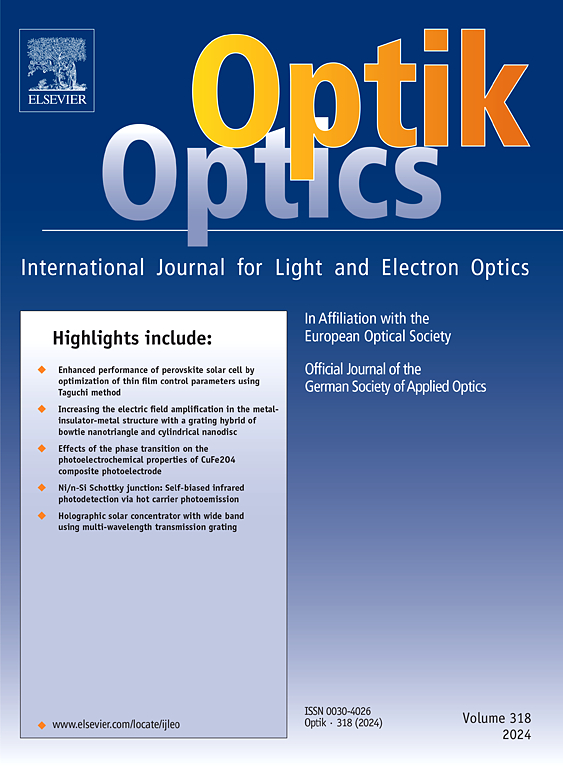Luminescence properties of Ho3+ ions in Pb3O4−B2O3−P2O5−ZnO-AIIIx (AIIIx=Al2O3, Ga2O3, and In2O3) glasses
IF 3.1
3区 物理与天体物理
Q2 Engineering
引用次数: 0
Abstract
Ho3+ doped Pb3O4−B2O3−P2O5−ZnO glasses, mixed with group IIIA oxides such as Al2O3, Ga2O3, and In2O3, are fabricated by conventional melting and quenching methods. X-ray diffraction, scanning electron microscopy (SEM), Energy dispersive spectrum (EDS) and Fourier transform infrared techniques (FTIR) were used to characterize these glasses. Optical absorption, Photoluminescence spectra and decay profiles were also registered. Photoluminescence spectra of the three glass compositions obtained at λₑₓc = 361 nm, showed prominent bands corresponding to 5F3,5S2, 5F5,4F4 →5I8 emission transitions. Among different glasses, the GaPBPZHo glass exhibited the maximal emission intensity. The emission spectra suggested that the ligands surrounding the Ho3+ ions in Ga2O3doped glasses exhibited greater asymmetry and lower covalence, enhancing their luminescence output. Notably, the quantum efficiency (η) of the 5S2→5I8 transition of Ho3+ ions was found to be the maximal for GaPBPZHo glass. The CIE chromaticity coordinates (x = 0.577, y = 0.385) for this glass indicated intense green emission, highlighting its potential for use in photonic devices and high-quality green light-emission applications.
Pb3O4 - B2O3 - P2O5 - ZnO-AIIIx (AIIIx=Al2O3, Ga2O3和In2O3)玻璃中Ho3+离子的发光特性
采用传统的熔炼和淬火方法,制备了掺杂Ho3+的Pb3O4 - B2O3 - P2O5 - ZnO玻璃,并与Al2O3、Ga2O3和In2O3等IIIA族氧化物混合。利用x射线衍射、扫描电镜(SEM)、能谱(EDS)和傅里叶变换红外技术(FTIR)对这些玻璃进行了表征。光吸收光谱、光致发光光谱和衰变谱也被记录下来。在λₑₓc = 361 nm处获得的三种玻璃组合物的光致发光光谱显示出与5F3、5S2、5F5、4F4→5I8发射跃迁对应的突出波段。在不同的玻璃中,GaPBPZHo玻璃的发射强度最大。发射光谱表明,在ga2o3掺杂玻璃中,Ho3+离子周围的配体表现出更大的不对称性和更低的共价性,从而增强了它们的发光输出。值得注意的是,在GaPBPZHo玻璃中,Ho3+离子的5S2→5I8跃迁的量子效率(η)最大。该玻璃的CIE色度坐标(x = 0.577,y = 0.385)显示出强烈的绿色发光,突出了其在光子器件和高质量绿色发光应用中的应用潜力。
本文章由计算机程序翻译,如有差异,请以英文原文为准。
求助全文
约1分钟内获得全文
求助全文
来源期刊

Optik
物理-光学
CiteScore
6.90
自引率
12.90%
发文量
1471
审稿时长
46 days
期刊介绍:
Optik publishes articles on all subjects related to light and electron optics and offers a survey on the state of research and technical development within the following fields:
Optics:
-Optics design, geometrical and beam optics, wave optics-
Optical and micro-optical components, diffractive optics, devices and systems-
Photoelectric and optoelectronic devices-
Optical properties of materials, nonlinear optics, wave propagation and transmission in homogeneous and inhomogeneous materials-
Information optics, image formation and processing, holographic techniques, microscopes and spectrometer techniques, and image analysis-
Optical testing and measuring techniques-
Optical communication and computing-
Physiological optics-
As well as other related topics.
 求助内容:
求助内容: 应助结果提醒方式:
应助结果提醒方式:


